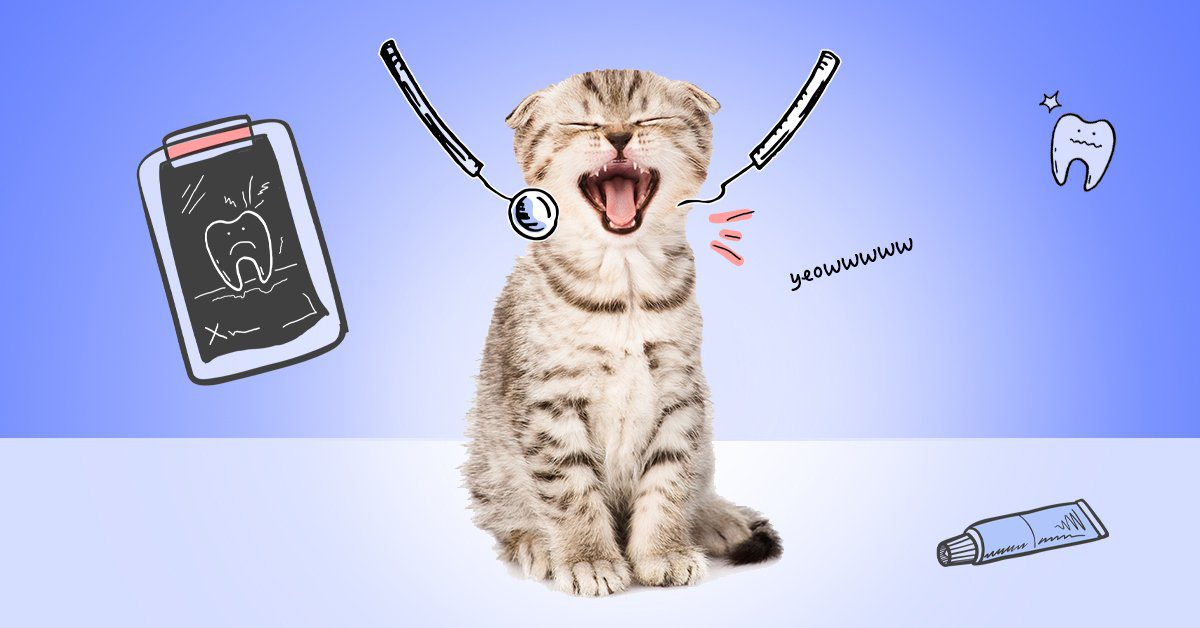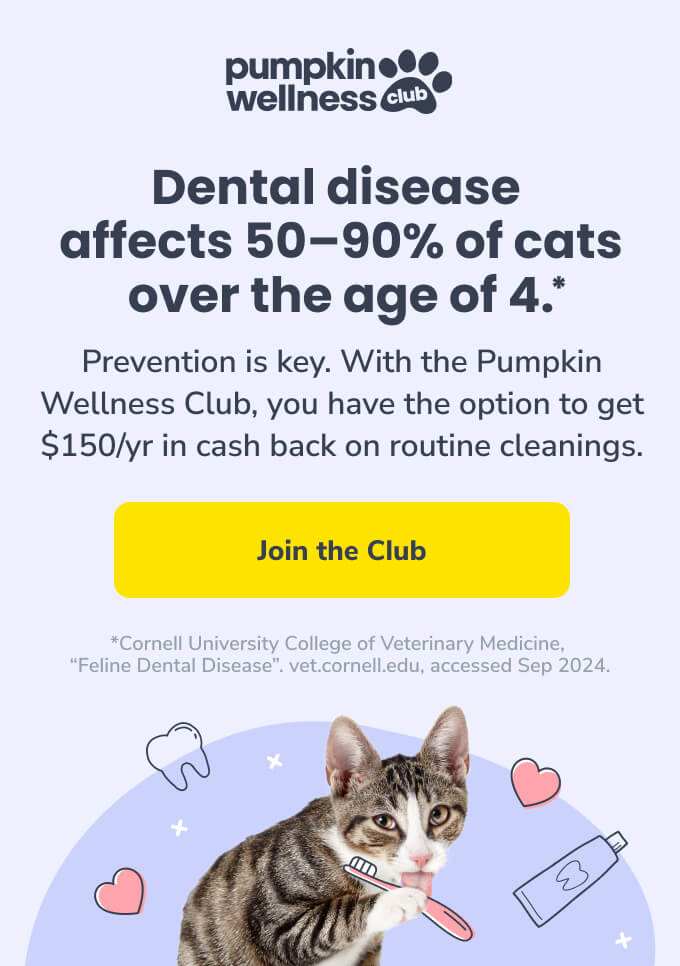Key Points:
- Cats need regular dental care — both at home and from a veterinarian — to protect against gum disease.
- More than half of cats over the age of 4 have dental disease, which can lead to tooth loss and chronic health problems.
- The Pumpkin Wellness Club* can help you plan ahead for the cost of your cat’s dental care by giving you the option to get up to $150 in cash back on yearly teeth cleanings.
Did you know that wild cats clean their teeth with the bones of their prey? It’s true: Wild or outdoor cats typically feast on rodents, consuming everything from the fur to the bones. That fur acts as dental floss, while crunching on bones helps break down plaque on the surface of their teeth.
Your indoor cat, that fearsome carnivore, probably isn’t regularly catching and eating mice or other small rodents. Without nature’s solution for dental care, your domestic kitty could probably use a teeth cleaning (or several) to help prevent dental disease.
Dental disease affects 50–90% of cats over the age of 4, yet most cat owners steer clear of their pet’s pointy chompers. It may be a daunting task, but you should commit to a home dental routine for your cat’s health — or at the very least, make sure to see a licensed veterinarian for routine dental checkups.
If you need an extra push, consider joining the Pumpkin Wellness Club to get cash back on your cat’s routine teeth cleanings and other preventive care services. Annual wellness visits, vaccinations, and routine health screenings are also eligible, so you can get up to $390 in cash back on your cat’s wellness care each year.
Don’t wait for a dental emergency to strike: It’s time to get familiar with your cat’s mouth and learn why you should keep it clean.
Inside a cat’s mouth
Cats are obligate carnivores. Their digestive system is designed to process high amounts of protein, with very few carbohydrates. With that comes a unique set of teeth designed for ripping and tearing — they’re much sharper than our human teeth designed for grinding. They also don’t have the same enzymes in their saliva to fight bacteria like we do, leaving them vulnerable to the early stages of dental disease.
The unique shape of cat teeth allows the food to get caught between the teeth and sit along the gumline. The combination of saliva, food, and bacteria creates plaque, a sticky substance that adheres to the surface of the teeth. This can cause redness, swelling, and pain along the gumline (a condition called gingivitis).
Without dental care, the plaque hardens to create tartar. The tartar adheres to the teeth around the gumline and even reaches under the gums to the roots of the teeth. If left to progress, tartar buildup quickly leads to periodontal disease, a painful condition that needs professional veterinary dental care.
Advanced periodontal disease can also trigger feline tooth resorption. This is the most common reason for tooth loss for cats, affecting 75% of cats over the age of 5. In these cases, the dentin in the tooth erodes to the point of infection, requiring extraction. It’s a painful condition for your cat and should be avoided at all costs.
When significant periodontal disease is present, the harmful bacteria produced in your cat’s mouth can enter the bloodstream. This can gradually damage your cat’s heart, kidneys, and liver — so remember, good dental care protects much more than your cat’s teeth.
Symptoms of dental disease in cats
Cats don’t show us when they’re in pain until it’s severe. Tooth or mouth pain is especially hard to spot because a cat will continue eating until the dental problems are advanced and very painful.
“Kitties stop eating for a myriad of reasons. Often when they stop eating, it can be worrisome and difficult to get them back to eating normally. Dental disease can be a common cause for decreased appetite.”
Dr. Michelle Vitulli, DVM, Caring Hands Animal Hospital
Dental disease is just one cause of decreased appetite in cats, so it’s important to look out for more specific symptoms, too. Be sure to report any changes in your cat’s eating habits and general behavior to your vet so they can make an accurate diagnosis.
Look out for these signs of feline dental disease in your cat:
- Bad breath
- Visible tartar or tooth discoloration
- Exposed tooth roots
- Red, swollen or bleeding gums
- Drooling that may contain blood
- Pawing the teeth or mouth
- Grooming less often
- Difficulty eating
- Weight loss
If you notice any of these symptoms, make an appointment to see your cat’s vet ASAP. You don’t want to let dental disease progress to the point where it will require more advanced care, which can be pricey and potentially risky for your pet.
Costs of dental care for cats
Dental care can be expensive, and most pet parents quake at the thought of it. Where you live, your cat’s age and health status, and the extent of medical treatment needed can all affect the price tag on your cat’s dental visit.
Keep in mind that a feline dental cleaning is far less expensive than a tooth extraction or more advanced care. The cost of a tooth extraction for cats can run between $300 and $1,300, which usually includes bloodwork, x-rays, cleaning, and medication. More severe dental procedures can quickly become more expensive.
“When I see a cat with mild or moderate dental tartar or gingivitis, I really try to stress to the owner that coming in for dental cleanings is going to cost less in the long run and also helps to keep their cat healthy and pain-free. The dental disease is only going to get worse with time, so by waiting and putting off a cleaning for a year or two, it will ultimately cost more at that time when extractions may be necessary. Also, the cat may end up dealing with pain or infection in the meantime.”
Dr. Meghan Dail, DVM, Mid-Atlantic Cat Hospital
Pet insurance may help with these expenses. Few pet insurance providers offer complete coverage for cat dental care, but the dental coverage offered by Pumpkin cat insurance plans can cover many costs associated with dental disease. Pumpkin also offers a separate wellness program that gives you cash back on routine preventive care. This coverage can help make it easier to invest in quality dental care for your cat’s health.
Pet Pro Tip: New to feline dental care? Join the Pumpkin Wellness Club, a new program that actually pays you for getting your cat the routine preventive care that they need to stay healthy. Members have the option to get up to $150 in cash for dental cleanings each year, plus even more savings on vaccines and annual health screenings.
Preventing dental disease in cats
Consistent dental care is the gold standard when fighting feline dental disease. Since most cats over the age of 4 have some type of dental disease, it’s best to start when your cat is a kitten. This can contribute to a longer life-span and happier life for your cat.
Here are three effective steps to support your kitty’s dental health:
- Nutrition & diet
- Regular professional dental checkups
- A home dental care routine
Let’s take a closer look at each step.
1. Nutrition & diet
Diet is an important factor in combating dental disease. A well-balanced, healthy cat food will protect your cat’s whole health, giving them the ability to fight off diseases and aid in healing.
Some cat parents believe kibble or hard food will provide the abrasive action needed to clean teeth. This isn’t true, unfortunately. Most cats don’t chew their food, but lap it up with their tongues and swallow it whole. Cat food manufacturers have developed many shapes of kibble to encourage a cat to bite or chew, but none clean the teeth adequately.
2. The dental checkup
Depending on your cat’s age, genetics, diet, and overall health, your vet may advise annual or twice-yearly dental examinations.
“Keeping on top of your cat’s oral health is of primary importance. The best way to do that is have your cat’s mouth evaluated by a veterinarian. If there is evidence of inflammation at the gum line, early intervention is key to a successful outcome.
Dr. Michelle Vitulli, DVM, Caring Hands Animal Hospital
At a routine dental checkup, the veterinarian will begin by scaling your cat’s teeth to remove plaque and tartar above and below the gumline. They then polish the teeth so plaque can’t easily stick to the smooth surface. Finally, the vet will rinse your cat’s mouth to dislodge any remaining tartar, plaque, and bacteria.
After the initial cleaning, your vet will do a physical exam of your cat’s mouth. This gives them a window into the condition of the teeth and jaw. Here’s what they will look for:
- How the teeth fit together and the jaw aligns (missing or extra teeth, an overbite, or an underbite)
- Fractured or broken teeth
- Plaque buildup on the teeth
- Gingivitis or periodontal disease
- Tartar buildup on the teeth and along the gum line
- Abscesses or signs of tooth resorption
- Bumps or lesions that may indicate a tumor
- Any facial swelling
Depending on the results of the physical exam and bloodwork, your veterinarian will develop a plan for your cat or schedule a more thorough examination. Many times, the vet can’t know the extent of the dental disease until the cat is under general anesthesia and they perform a complete dental exam, including x-rays.
Oral surgery
If the vet determines your cat needs oral surgery, they may call in a veterinary dental specialist to perform advanced procedures. This can include excising gums with severe periodontal disease, extractions of damaged or impacted teeth, or removing oral tumors.
Oral surgery can sound frightening, especially for devoted pet parents of older cats. Don’t worry too much: Most cats will bounce back quickly and regain their appetite after surgery resolves the problem that’s causing them pain. However, age and existing health conditions, such as obesity, may pose additional risks that you should discuss with your vet before scheduling a procedure.
“We see all our patients one week after extractions for a follow up visit. It still amazes me when I talk to a client after their cat had a painful tooth extracted and hear how quickly their kitty resumed eating. Many cats return to eating with gusto soon after a diseased tooth is surgically extracted.”
Dr. Michelle Vitulli, Caring Hands Animal Hospital
3. Dental care at home
A good home dental care routine includes brushing your cat’s teeth regularly, providing dental care supplements or chews, and maintaining a healthy diet.
Many cats don’t take kindly to humans messing with their mouths, but it’s possible to ease them into the process with patience and treats. The earlier you can start your cat on dental care, the easier it will be.
Brushing your cat’s teeth
Brushing your cat’s teeth is the backbone of preventative oral care. Ideally, you should brush your cat’s teeth daily, but at least three times per week will still improve your cat’s oral health and help prevent gum disease.
“Start young! Training a kitten to allow you to brush their teeth is going to be your best bet for long-term success. Just like getting them used to touching their paws at a young age will make nail trims easier, getting them used to you touching the outside of their mouth, opening their mouth, and touching the outside of their teeth, will make trying to get in there with a toothbrush much easier.“
Dr. Meghan Dail, Mid-Atlantic Cat Hospital
If you’re not sure where to start, you can always ask your vet for some direction. Many veterinary offices carry cat-friendly toothpaste and toothbrushes. You may also want to purchase dental gauze and/or a finger brush from your local pet store.
Get your cat used to you messing with their face and mouth before you introduce the toothbrush. Gently rub around their mouth to start, and gradually, when your cat is more comfortable, try touching or rubbing their teeth and gums.
The next step is to add the toothpaste. Cat toothpaste comes flavored with chicken or fish, so most cats readily accept it. A dab on your finger is all you need. Let your cat smell and lick it, and if they like it, try rubbing it gently on the outside of their teeth.
Once you accomplish that step, try introducing the toothbrush, finger brush, or gauze with toothpaste. Gently rub it against the outside of the teeth in small, slow circles, and be sure to massage the gums as well.
Dental products for cats
If your cat doesn’t welcome tooth brushing (and many don’t), alternative dental products will meet their dental care needs between vet-directed cleanings.
The most reliable source for dental products is the Veterinary Oral Health Council (VOHC). They provide a comprehensive list of products they endorse (through rigorous testing) on their website. Each product lists all ingredients so you can decide which is best for your cat.
Dental treats and supplements
You’ll want to look for dental treats containing ingredients that de-mineralize plaque and tartar, and enzymes that fight bacteria. Sea kelp, for one, is a good additive for fighting tooth decay and bacteria in the mouth. Cats generally like it, and you can add a tiny bit to their regular food.
Types of dental treats include chewables and oral rinses (typically sprays to be spritzed inside your cat’s cheek). You can also apply an oral rinse on a gauze pad and rub inside your cat’s cheek or along the gums.
Dental diets
For cats diagnosed with dental disease, their vet may prescribe a special food designed to reduce the growth of bacteria and plaque in the mouth. The food pieces are larger, encouraging chewing or biting to create the abrasive action of cleaning the teeth.
In conclusion, dental disease is serious and can increase your cat’s risk of some cancers, diseases of the heart and lungs, gastrointestinal problems, and kidney disease. Proper and consistent dental care will extend your cat’s lifespan and improve their quality of life.
The final word on cat dental care
Your kitty’s yearly exam is a great time to discuss their dental health with your veterinarian and learn what preventive care, treatments, and daily home habits they recommend. And don’t forget to check out the Pumpkin Wellness Club for options to save on routine dental care!
DISCLOSURE






